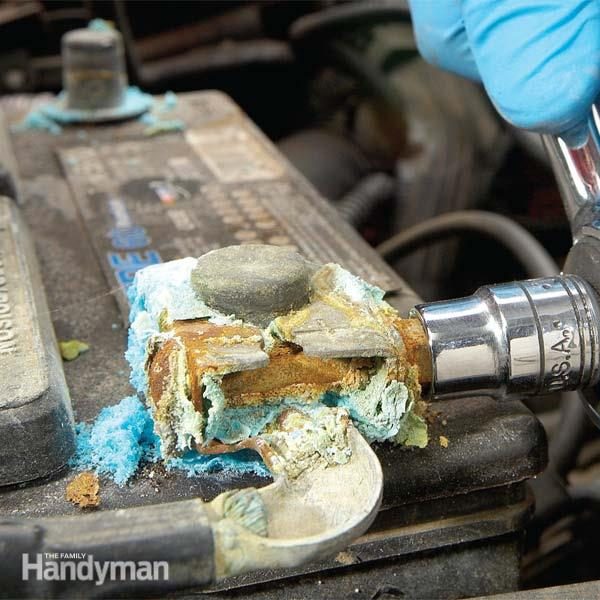Cleaning your car battery and corroded battery terminals is an important part of keeping your vehicle starting and running smoothly.
15 – 20 Minutes
Beginner
$10 - 25
Introduction
Corroded battery terminals can cause several problems with your car. They can prevent the battery from fulling charging, drain the battery (resulting in your car not starting), and can also cause major damage to the alternator. Cleaning battery terminals is an easy, inexpensive preventive maintenance measure you can do yourself in about 10 minutes.
Knowing how to clean corroded battery terminals is a useful skill; especially because it only takes about ten minutes one you know how to do it. We’ll walk you through the steps and show you some tricks along the way to prevent corrosion from happening again.
Safety Note: A battery contains sulfuric acid that can cause serious burns. Always wear gloves and eye protection when working around a battery. Smoking, flames, sparks, or other ignition sources can cause a battery to catch fire or explode. Exercise caution when jump-starting or working near a battery with metal tools to prevent short circuits and sparks. If you come into direct contact with battery acid, flush with plenty of water and seek medical attention immediately.
Tools Required
- Battery cable puller (optional)
- Battery memory saver with a fresh 9 volt battery or a battery jump starter
- Battery terminal cleaning tool or sandpaper
- Old toothbrush or stiff non-metallic parts cleaning brush
- Safety glasses
- Slip joint pliers (optional)
- Socket/ratchet set
- Work gloves
- Wrench set
Materials Required
- Baking soda or spray battery cleaner
- Battery terminal anti-corrosion washers
- Battery terminal covers (if missing)
- Battery terminal protective spray or grease
- Bucket of clean water or garden hose
- Dielectric grease or Vaseline
- Disposable container
- Disposal shop or paper towels
- Distiller water (optional)
Watch How to Clean Corroded Battery Terminals
Project step-by-step (6)
Memory Saver Backup Battery
- Having a 12-volt backup battery will save all the memory stored in your car’s computer, radio and clock.

- Connect it directly to the battery terminals before disconnecting them. Or plug a 12-volt power source directly into a > Save : Computer Code, Radio Code, OBD11 | Code 12 Volt Attaches to Power PortCar/Truck/Van” data-product-price=”14.22″ data-product-category=”Automotive Parts and Accessories” data-product-retailer=”autopartssupplygroup” data-content-rating=””>cigarette lighter or OBD II port.
- It’s very important not to connect the positive and negative leads together or you will blow a fuse.

Disconnect the Terminal Clamps
- First, determine the positive and negative terminals. The positive (+) has a red cover or cable, and the negative (-) has a black cover or cable.
- It’s very important to FIRST disconnect the negative terminal clamp from the battery post, using a wrench or socket, then disconnect the positive terminal clamp from the battery post.

Cleaning the Terminals
- There are a few ways to clean the car battery terminals – some home remedies include Coca-Cola, baking soda, and hot water. You can also purchase battery terminal cleaning spray.
- Clean both battery posts and terminals with the cleaner of choice.

- Rinse the terminals with water and wipe dry.
- Deep clean the battery posts and terminal clamps, using a battery terminal cleaning tool.

Apply Grease
- Coat both terminals and battery posts with dielectric grease or Vaseline.
- This step helps to both lubricate the terminals as well as protect them from future corrosion.

Install Terminal Clamps
- Always install the positive terminal clamp first, followed by the negative terminal clamp.
- Tighten clamps with a wrench or socket.

Corrosion Prevention
- Coat both terminals with battery terminal protection to help prevent corrosion.
- Using this in addition to the grease or Vaseline helps to give you more peace of mind and double the protection.
- Fortunately, now that you know how to clean corroded battery terminals, you can do this repair without too much trouble. But extra protection is never a bad thing.




















